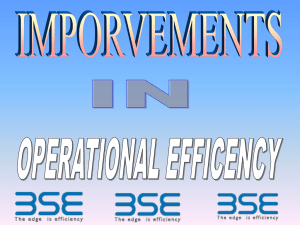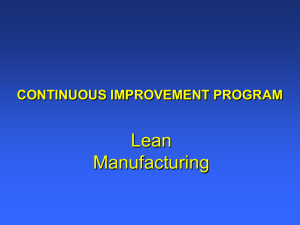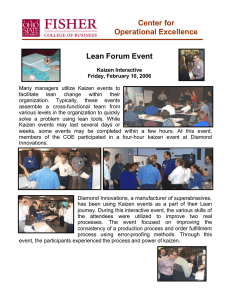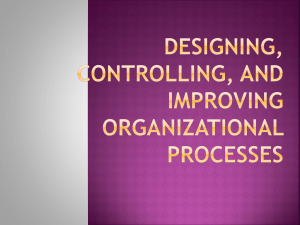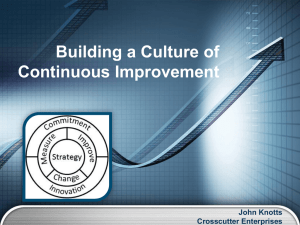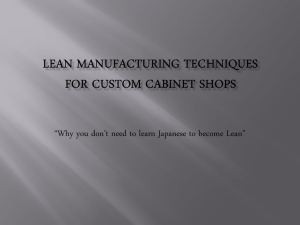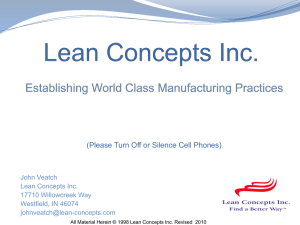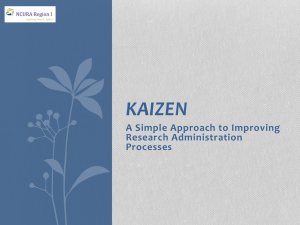Introduction-to-kaizen
advertisement
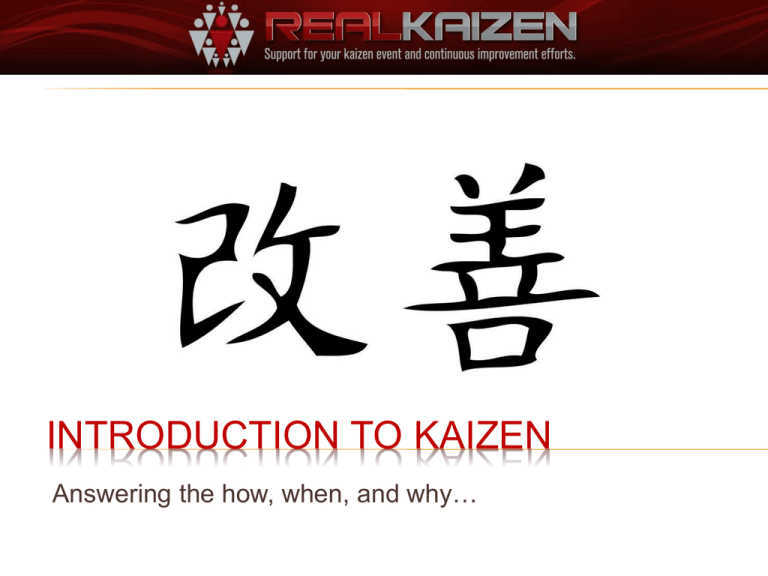
INTRODUCTION TO KAIZEN Answering the how, when, and why… WHAT IS KAIZEN? Kai = Change; Zen = Good Kaizen = Good Change, Change for the Better, Continuous Improvement Small, incremental changes; break apart and put back together better Focus on small, quick changes for long-term success Elimination of the 8 Wastes http://REALKaizen.com 2 WHAT IS KAIZEN? Kaizen is: Rapid improvement in a particular work cell, work station, small process, factory location, office area, etc. Kaizen is not: Improvements in complex cross-functional or systemic problems where Projects or 6-Sigma are required http://REALKaizen.com 3 KAIZEN TARGETS Eliminate waste (non value added activities) Increase productivity / output Reduce inventory (less material and labor) Reduce cycle time (less time to produce specific part) Reduce space (work cell, office area) Improve On-Time Delivery (OTD) Improve quality of product and process Improve housekeeping, 5S and visual management Reduce downtime (setup time, maintenance) Reduce transport time and distance Standardize the process (less variation) Reduce operating costs http://REALKaizen.com 4 GROUND RULES & GUIDELINES Try to make all improvements within the event area. Avoid blame on suppliers (internal or external) Don’t accept excuses. Just say no to “we’ve always done it that way” and the status quo. Keep an open mind to change Think of how it can be done, not why it won’t work. Don’t make excuses-just make improvement happen Ask “why” five times until you get to the root cause of the problem (The 5 Why’s) The Team solution is usually the best solution Don’t over-analyze. Understand the process, then “just do it,” and see if it works Don’t seek perfection the first time. Do something now – a 20% improvement is better than nothing http://REALKaizen.com 5 GROUND RULES & GUIDELINES “Fast and crude” is better than “slow and elegant” or “maybe never”. In the worst case, the original process can be restored Never leave in silent disagreement; Silence is agreement = ‘I can live with it’ Every person has a voice and there is no such thing as a dumb question Keep a positive attitude and have fun. The possibilities for improvements are unlimited Everyone respect everyone else http://REALKaizen.com 6 WHAT IS LEAN? Lean production focuses on eliminating waste in all processes Lean production is not about eliminating people Lean production is about expanding capacity by reducing costs and shortening cycle times between order and ship date Lean is about understanding what is important to the customer http://REALKaizen.com 7 VALUE ADD & NON-VALUE ADD Value Adding Activity An activity that transforms or shapes product or information to meet customer requirements. Value added is always determined from the customer’s perspective. How would you define value for your customers? Non-Value Adding Activity Those activities that take time, resources or space, but do not add to the value of the product itself. http://REALKaizen.com 8 VALUE ADD & NON-VALUE ADD Value Add – Activities that are performed that the customer is willing to pay for Value Enabling – Activities that support Value Add Waste – Activities that do not contribute to Value Add http://REALKaizen.com 9 VALUE ADDING ACTIVITY Steps that could be considered essential because they: Physically change the product / service Are done in the right sequence or location in the process Provide a real and sustainable competitive advantage Would be seen by the client as delivering the value they seek that they would be willing to pay for them http://REALKaizen.com 10 VALUE ENABLING ACTIVITY Steps that could be considered necessary because they: Support company measurement or reporting requirements? Reduce risk, defect, cost, etc. Allow subsequent work for the customer to be performed more quickly or accurately Satisfy legal or regulatory requirements Satisfy good business practice requirements http://REALKaizen.com 11 WASTE Steps that could be considered nonessential because they: Do not change/add to the product or service to be delivered Are done out of sequence and/or are performed to correct prior actions Would not be seen by the client as delivering value and so they would be unwilling to pay for them http://REALKaizen.com 12 8 WASTES http://REALKaizen.com 13 WASTE 1 - TRANSPORTATION Definition Causes Unnecessary movement of items between processes Poor layout and/or process Design & Planning Unstructured or not understood Value Stream Complex Material flow Problems Increased Time & Cost to transport & search Increased Defects due to accidents http://REALKaizen.com 14 WASTE 2 - INVENTORY Definition Causes Any raw material, Work in Progress (WIP) or finished goods which are being stored Overproduction causes inventory build up between processes Problems Adds cost Requires space Hides process defects Can become a defect http://REALKaizen.com 15 WASTE 3 - MOTION Definition Causes Unnecessary movement within a Process Poor workplace layout Poor process planning Poor Housekeeping No Standard Operating Procedures Problems Adds time & cost Can be a safety issue http://REALKaizen.com 16 WASTE 4 - WAITING Definition Causes People or Parts that are waiting for a work cycle to be completed Unreliable Supply Chain Bottlenecks Down Time Problems Excessive Lead Time Causes Bottle Necks Additional Time & Cost http://REALKaizen.com 17 WASTE 5 – OVER PROCESSING Definition Causes Processing beyond the value required by the Customer Lack of Customer Focus “Always done it this way” Lack of understanding Scheduled work time is longer than needed Problems Increases Time & Cost http://REALKaizen.com 18 WASTE 6 – OVER PRODUCTION Definition Causes To produce items sooner or in greater quantities than required for customer demand Poor planning Incorrect bottleneck assumptions Problems Overproduction discourages a smooth flow of production Leads to excessive work in process inventory http://REALKaizen.com 19 WASTE 7 – UNDERUTILIZED PEOPLE Definition Causes Underutilization of people’s Abilities, Knowledge, and Skills Constant management turnover unaware of talent pool Employee not happy in current position Problems Great ideas might be missed Dominant personalities may force focus in wrong direction http://REALKaizen.com 20 WASTE 8 - DEFECTS Definition Causes A defect is when the Customer believes they did not get what they paid for Process Variation Customer requirements not understood Problems Additional Time & Cost Reduces Customer Confidence http://REALKaizen.com 21 POTENTIAL NON-VALUE ADD OPPORTUNITIES http://REALKaizen.com 22 KILL THE “RE’S” Action verbs that start with “re” usually bad news: Rework Retest Retool Recall Reject Retrain, etc. Restock http://REALKaizen.com 23 STEPS TO ELIMINATE WASTE Brainstorm! Clearly identify business, processes or area to focus improvements on where bottlenecks, high costs, or long throughputs exist Perform detailed “current state” process analysis through value stream mapping, time and motion studies, video, measurements, interviews with employees, collect process data, stand and observe the process, etc. Identify “value-added”, “non value-added but necessary” and “waste”. Define “ideal / future state” map for the targeted process (What should it be without any or with minimum waste?). Justify improvement benefits in safety, quality, customer and financial impact http://REALKaizen.com 24 STEPS TO ELIMINATE WASTE Involve employees and perform Kaizen events; apply problem solving & analysis (Plan-Do-Check-Act); define and prioritize solutions. Set action plans to get from current state to future state (assign ownership for improvements, set timelines and follow-up method). Execute improvements and follow-up on agreed actions. Train employees; document and standardize the process based on improvements made. Reflect and learn from the process (what we did right and what we did wrong, how to improve in future). http://REALKaizen.com 25 THE VISUAL FACTORY Describes how information and data flows. Uses visual methods to display and convey how material flows, where it is located, and how the work is accomplished. Visual Factory tools include Andon boards, signs, and charts. http://REALKaizen.com 26 5S Workplace organization standard focused on efficiency, effectiveness, and safety Sort (Seiri) Straighten, Set in order (Seiton) Shine, Sweep (Seiso) Standardize (Seiketsu) Sustain (Shitsuke) http://REALKaizen.com 27 5S - BEFORE Workplace Targets Office (Before) Factory (Before) http://REALKaizen.com 28 5S - AFTER Office (After) Factory (After) http://REALKaizen.com 29 IMPORTANCE OF THE VISUAL IMAGE http://REALKaizen.com 30 IMPORTANCE OF THE VISUAL IMAGE All factories should be as clean as “Clean Rooms” http://REALKaizen.com 31 RULES TO GOOD HOUSEKEEPING Remove / eliminate everything you don’t need from the floor, drawers, shelves, etc. Gain space and eliminate waste (simplify) Everything left will have a clearly defined place (lined-up & identified) Everything left will be clean and neat (regularly cleaned, repainted, etc.) Ownership in the area Keep the area neat and don’t let others mess it up http://REALKaizen.com 32 WASTE ID – GEMBA/MUDA WALK Spend 1 to 2 hours in the area identifying waste Write down every waste you see for 30 minutes (use form) Prioritize and identify top 3 (15 minutes) Propose solutions (15 minutes) Discuss with Team all opportunities while in the area following the process (1 hour) http://REALKaizen.com 33 GOING LEAN THRU KAIZEN Turn This… …Into This! http://REALKaizen.com 34
